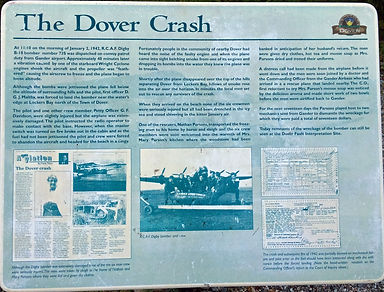Digby Bomber Crash in Dover
Dover, Hare Bay
On January 2, 1941 a Royal Canadian Air Force B-18 Digby took off from Gander en route to patrol and protect a convoy of allied ships on their way to Britain. Shortly after take-off, however, the overloaded aircraft began experiencing engine problems. After several attempts by the aircraft's crew to try and fix the problem and return back to the airport, the plane crashed into the ocean near the community of Dover and Hare Bay.
The aircraft was carrying six men including flying officer Don Maltby. Maltby knew the possible dangers of overloading his plane with supplies and ammunition but felt it was necessary to complete the mission assigned to them. The crew was ordered to fly almost 500 km (300 miles) east of Gander and intercept an allied ship convoy on their way to Great Britain. There they would patrol and defend the convoy if needed from German U-boats.
The Aircraft
The aircraft was a Douglas Digby Mark 1. It began its life as a Douglas DC-2 but after it was determined the plane was underpowered and its payload to small, it was converted for antisubmarine patrol. The aircraft had two 1000 horsepower Wright radial engines which gave it a max take-off weight of 27000 lbs. and a max speed of 348 km/h (216 mph). It could hold 6 crew members and had an 89 foot wingspan and overall length of 57 feet. The aircraft consisted of three .30-inch machine guns and a 4400 lbs. explosive storage space.

To complete the mission assigned, Maltby’s aircraft was fully loaded with machine gun ammunition and depth charges. Also loaded aboard was food and supplies for the crew. Maltby knew that his aircraft would be on the verge of being over the recommended weight limit but proceeded anyway in the belief that the aircraft could handle such a load as long as both engines worked properly.



Disaster
At 11:10 AM the aircraft and its crew took off from Gander International Airport. 40 minutes later as they flew over the communities of Dover and Hare Bay, vibrations began shaking the plane. Shortly after a loud bang was heard from the aircraft's right engine and upon closer inspection was observed to have caught fire. Within 30 seconds the crew had successfully extinguished the fire but the plane was already losing altitude uncontrollably.
Maltby had noticed a body of water away from houses and buildings and in an attempt to lighten the aircraft, jettisoned the aircrafts depth charges. The depth charges exploded as they hit the surface of Salt Water Pond. The explosions were said to awake/startle many people in Dover and Hare Bay. Many of these people were worried that a German U-boat was attacked by the aircraft.
Maltby knew the plane would not make it back to Gander and that he would have to make an emergency landing near the shoreline. His next fear was that the full tanks of fuel would ignite once they hit the water. To mitigate the chances of this happening the crew disconnected the planes electrical circuits to prevent sparks from igniting the fuel.
The plane crashed into the water near the shoreline in Locker’s Bay. Miraculously all crew members survived with only minor injuries. As the plane sat in the water the men reconnected the planes electrical systems in order to send a mayday signal. The electrical surge, however, sparked a fire which forced the men to evacuate into a small dinghy.
The Rescue
The famous photo of the aircraft being dragged out of the water and onto the beach in Dover. Photo source: www.townofdover.ca
By this time men and woman from the surrounding communities came running to the beach to aid however they could. The dinghy carrying the wet and cold crew washed ashore shortly after and they were brought into the warm house of Mary and Nathan Parsons where they were provided with dry clothes and food. Once safe they retried sending a distress signal to Gander and shortly after a rescue plane was sent and the crew was airlifted back to Gander.
Two mechanics remained with the aircraft to salvage it from the frigate water and send it back to Gander. They remained in the town for 17 days as the aircraft was pulled ashore and dismantled.

Many great stories from locals have been told about the crash and the generous people who helped the crew survive. An investigation led to the cause being blamed partially on mechanical failure and pilot error. It was decided that the best thing for the pilot to have done was to jettison the fuel out of the plane with the depth charges.
On top of a hill overlooking the town of Dover, a memorial has been created for recognition of the kindness and generosity that the people for the community showed that day. A piece of the wreckage has been mounted as a reminder of the incident.
Sources & Further Exploring
The Dover Crash by Frank Tibbo. Gander Airport Historical Society website found www.ganderairporthistoricalsociety.org/_html_war/The.Dover.Crash.htm.
Dover Plane Crash. Town of Dover’s website found at www.townofdover.ca/events.php.



